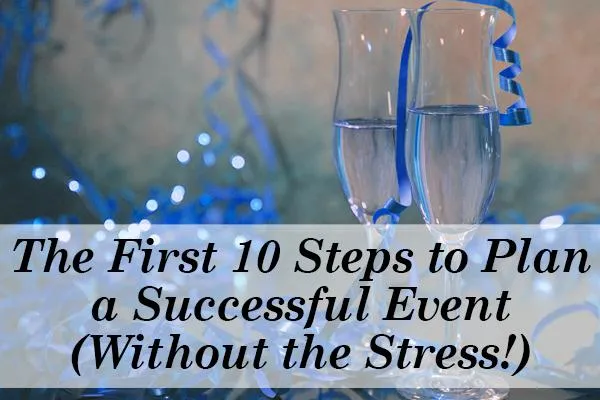EVENT PLANNING TIPS

The First 10 Steps to Plan a Successful Event (Without the Stress!)
Planning an event can feel overwhelming, but with the right strategy, you can create an unforgettable experience—whether it’s a wedding, corporate gathering, or private celebration. To help you stay on track, we’ve outlined the first 10 essential steps to ensure your event is well-organized, engaging, and stress-free.
Step 1: Define Your Event Goals and Objectives
Before diving into logistics, ask yourself:
What’s the purpose of this event? (Networking, education, celebration, fundraising?)
Who is your target audience?
What experience do you want attendees to have?
Setting clear goals will shape every decision you make moving forward.
Step 2: Establish Your Budget
Your budget dictates the scale and style of your event. Factor in:
Venue costs
Catering
Entertainment
Marketing & promotions
Equipment and rentals
Having a realistic budget helps you prioritize spending without unexpected surprises.
Step 3: Choose a Date and Secure a Venue
Consider these key factors when selecting a date:
Availability of your preferred venue
Conflicts with other major events or holidays
Time needed for planning and promotion
Book your venue early to lock in the best rates and avoid last-minute scrambling.
Step 4: Create an Event Timeline
A well-planned timeline keeps everything on schedule. Map out:
Planning milestones (e.g., when to send invitations, book vendors)
Day-of-event schedule (setup, activities, wrap-up)
Post-event follow-ups (thank-you emails, surveys)
Pro tip: Work backwards from your event date to ensure deadlines are realistic.
Step 5: Build Your Event Team
A successful event requires a strong team. Assign roles like:
Event Planner/Coordinator – Oversees everything
Marketing & Promotion Lead – Manages outreach and RSVPs
Logistics & Vendor Manager – Handles contracts and vendor relations
On-Site Support Staff – Helps with setup and guest services
Having clear responsibilities avoids confusion and last-minute chaos.
Step 6: Book Key Vendors
Once your budget and venue are set, it’s time to secure vendors such as:
Caterers (food & beverage)
Entertainment (DJ, live band, speakers)
Photographer/Videographer
AV & Lighting
Decor & Rental Companies
Always read reviews, compare quotes, and ask for contracts to ensure smooth partnerships.
Step 7: Plan the Guest Experience
Think beyond logistics—how will guests feel at your event? Consider:
Engaging activities (games, networking stations, interactive elements)
Comfortable seating arrangements
Personalized touches (custom name tags, giveaways)
A smooth check-in process
An immersive experience keeps attendees talking about your event long after it ends.
Step 8: Market Your Event
The best event in the world won’t succeed if no one shows up! Promote your event using:
Social Media – Create engaging posts, teasers, and countdowns
Email Invitations – Send out personalized invites
Event Website – Provide details and RSVP options
Influencers & Partnerships – Collaborate to extend your reach
The earlier you start, the more buzz you’ll build.
Step 9: Finalize Logistics and Contingency Plans
A smooth event requires double-checking:
Equipment setup (test microphones, projectors, WiFi)
Seating charts and floor plans
Vendor arrival times
Bad weather backup plans (if outdoors)
A Plan B ensures you’re prepared for any surprises!
Step 10: Execute and Enjoy!
The big day has arrived! Stay on top of:
Final walkthroughs before guests arrive
Clear communication with vendors and team members
Keeping energy high and problem-solving quickly
Capturing event highlights (photos, videos, social media posts)
Pro tip: Delegate so you can actually enjoy the event you worked so hard to plan!
Final Thoughts
Event planning doesn’t have to be overwhelming. By following these first 10 steps, you’ll set yourself up for a seamless, engaging, and unforgettable experience.
Need professional event support? Contact us today for expert guidance in bringing your vision to life!


